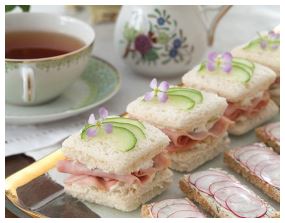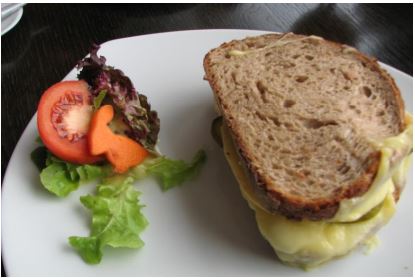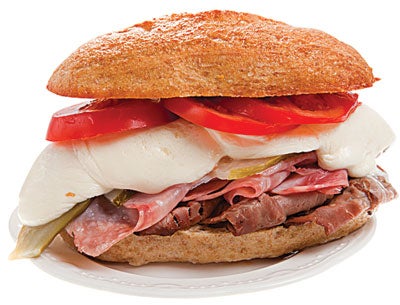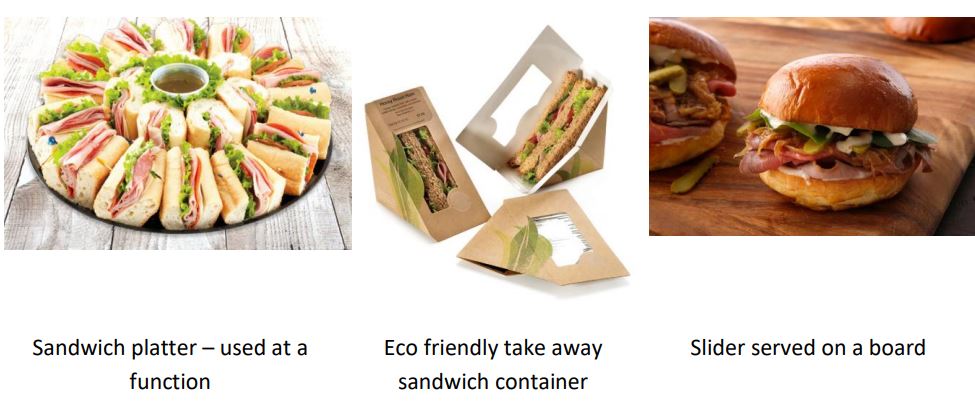Sandwich Presentation

Presentation
The methods of presenting sandwiches will depend on the use of the product; will they be used for buffets or afternoon teas; if so, then platters may be used. For takeaways sealed containers or paper bags with the establishment’s logo could used, while in a café or hotel crockery with, perhaps, a simple salad to garnish can be an offered.
Whatever the case clean serviceware is essential so the product looks appetising and to avoid cross contamination. Presentation styles will depend on the service period (breakfast, lunch, etc.), the type of sandwich requested, the organisation’s standards and customer expectations.
Sandwiches should be neatly cut and presented in ways that make them attractive to the eye. Consider the use of a variety of flavours, colours, textures, accompaniments and garnishes. Remember that plate size and style of packaging will also contribute to the appeal.

Accompaniments and Garnishes

Garnishes are edible decorations that are used to add texture and colour; enhancing the presentation of the food. They must be clean, fresh, colourful, edible and complimentary to the food being served. They can include (but are not limited to);
- fresh herbs (parsley, basil, coriander)
- sliced of wedged vegetables and fruits (lemon, tomato, cucumber and pineapple)
- carved vegetables (carrot, radish).
The types of garnish being used must match the food, for example;
- a teriyaki chicken sandwich could be garnished with a sprig of fresh coriander
- a grilled ham, cheese, avocado and pineapple doorstop could be garnished with a thin slice of fresh pineapple and a small sprig of mint
- a smoked salmon sandwich could be garnished with a light twist of lemon
- Bruschetta can be garnished with fresh basil leaves.
The garnish should not overwhelm the food; if food is over-garnished it can be unattractive, crowded and the garnish then becomes an accompaniment – not a garnish.

Accompaniments on the other hand are part of the dish, but not the main part of the dish. They can be included as part of a sandwich filling, or are sometimes served alongside. For example, smoked salmon is often accompanied by capers, thinly sliced raw onion and/or sour cream/watercress cream while a roast beef sandwich can be accompanied, either as part of the filling or in a small sauce dish alongside, by horseradish cream or mustard.
Other dressings, sauces, condiments or a small fresh salad might also accompany the sandwich either on the same plate on in a side dish.

Visually Evaluate Dish and Adjust Presentation

As a food professional, it is vital for you to continuously create and improve your dishes to excite your customers and keep your menu fresh. By putting your food through a proper evaluation process, you can ensure that new dishes are of the right quality as well as identify areas to improve your current offerings.
Before offering a dish to the customer it should be visually checked to ensure the presentation is appealing and appetising. Things to check for include;
- Appearance -This covers the visual appeal of a dish including the way it is presented. When evaluating appearance, consider the following:
- Overall colour and colour combinations
- Sizes and shapes of ingredients
- Visual attractiveness
- Eye appeal
- Signs of freshness
- Odour - Our sense of smell plays a large part in the way we perceive flavours. Odours or aromas can be described as tangy, herby, earthy, fruity or even floral, varying in strength. When evaluating the smell of a dish, you should place the sample at least one inch from your nose before breathing in.
- Taste - The way that a dish tastes comes from its combination of flavours as well as its serving temperature. Take a small bite, chew slowly and allow yourself to experience how the flavours pair with one another, noting the intensity of each flavour. Record comparisons and observations within 10 seconds after tasting for easy recall.
- Texture and Consistency - This covers all the physical qualities you can feel with your finger, tongue, palate or teeth. When evaluating the texture of food, chew slowly and take note of the various characteristics in each mouthful. Be sure to watch out for when a dish is especially grainy, hard or even sloppy.

